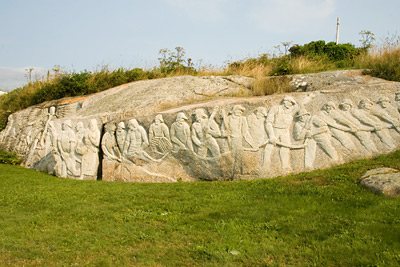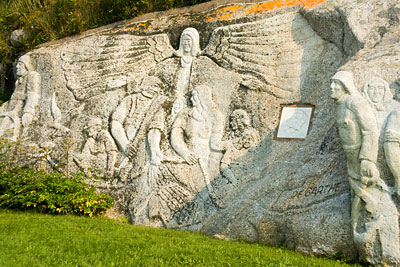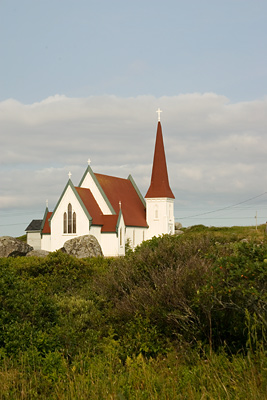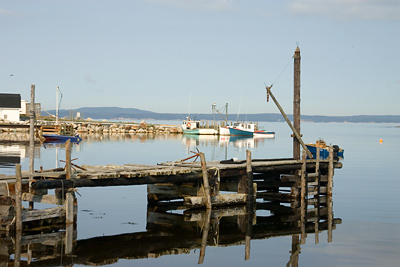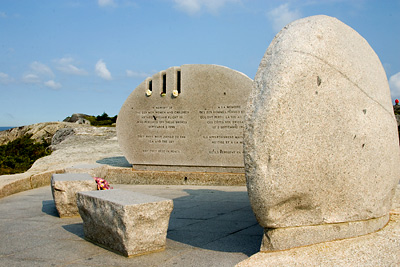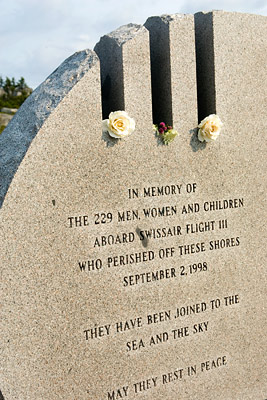Ken's Journal Halifax, Nova Scotia |
This is the "Fisherman's Monument" by William DeGarthe, Artist and Sculptor. The work was done on a granite rock in the back yard of his home. "The work of art is a lasting memorial to the gallant men of Peggy's Cove, who harvest our oceans." From left to right it depicts a fisherman's family, Peggy of the Cove and fishermen at work. |
Fishermen at work. |
A Fisherman's Family and Peggy of the Cove. |
St John's Church at Peggy's Cove. |
Another small harbor on the way back to Halifax. |
| It is recorded in the minute book of St. John's Church, that a public meeting was
held in 1847 for the purpose of collecting money to build the community's first
church. Over one hundred people contributed pounds, shillings, and pence towards
the cause and between the years of 1847 and 1850, St. John's Church was erected. This church unfortunately burnt to the ground in 1881 and a second public meeting was held for the purpose of raising funds for the second church. The second church, the one you see today, was built between the years of 1881 and 1883 and is still being used by the people of the Cove today. St. John's Church is open to the public on a limited basis throughout the summer months. As this picture was taken, there were a bunch of contractors vehicles parked out front - In this view, hidden behind the brush. |
|
Does anyone remember Swissair Flight 111? It went down just off the coast here on September 2, 1998. All 229 aboard the flight perished. This is a monument to them just a couple miles down the road from Peggy's Cove. |
The notches in the rock represent the number of the flight - 111. If you get behind the monument and look through the notches, they are oriented with the location in the ocean where the plane went down. |
A Synopsis of the Canadian TSB investigation of the crash. On 2 September 1998, Swissair Flight 111 departed New York, United States of America, at 2018 eastern daylight savings time on a scheduled flight to Geneva, Switzerland, with 215 passengers and 14 crew members on board. About 53 minutes after departure, while cruising at flight level 330, the flight crew smelled an abnormal odour in the cockpit. Their attention was then drawn to an unspecified area behind and above them and they began to investigate the source. Whatever they saw initially was shortly thereafter no longer perceived to be visible. They agreed that the origin of the anomaly was the air conditioning system. When they assessed that what they had seen or were now seeing was definitely smoke, they decided to divert. They initially began a turn toward Boston; however, when air traffic services mentioned Halifax, Nova Scotia, as an alternative airport, they changed the destination to the Halifax International Airport. While the flight crew was preparing for the landing in Halifax, they were unaware that a fire was spreading above the ceiling in the front area of the aircraft. About 13 minutes after the abnormal odour was detected, the aircraft's flight data recorder began to record a rapid succession of aircraft systems-related failures. The flight crew declared an emergency and indicated a need to land immediately. About one minute later, radio communications and secondary radar contact with the aircraft were lost, and the flight recorders stopped functioning. About five and one-half minutes later, the aircraft crashed into the ocean about five nautical miles southwest of Peggy's Cove, Nova Scotia, Canada. The aircraft was destroyed and there were no survivors. For a copy of the whole report, go here. |
"A journey is like marriage. The certain way to be wrong is to think you control it." –- John Steinbeck
|
Page 38 |
